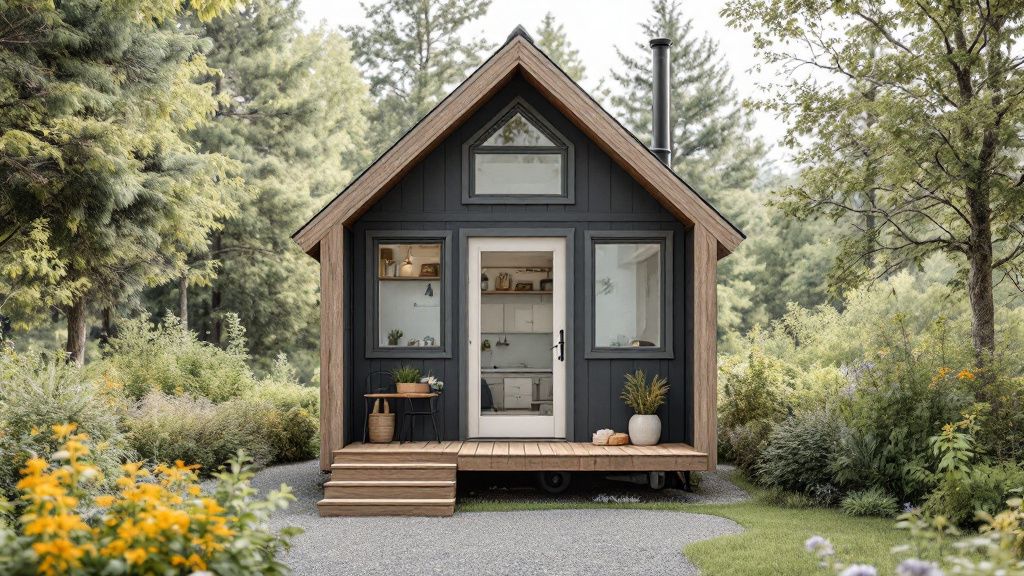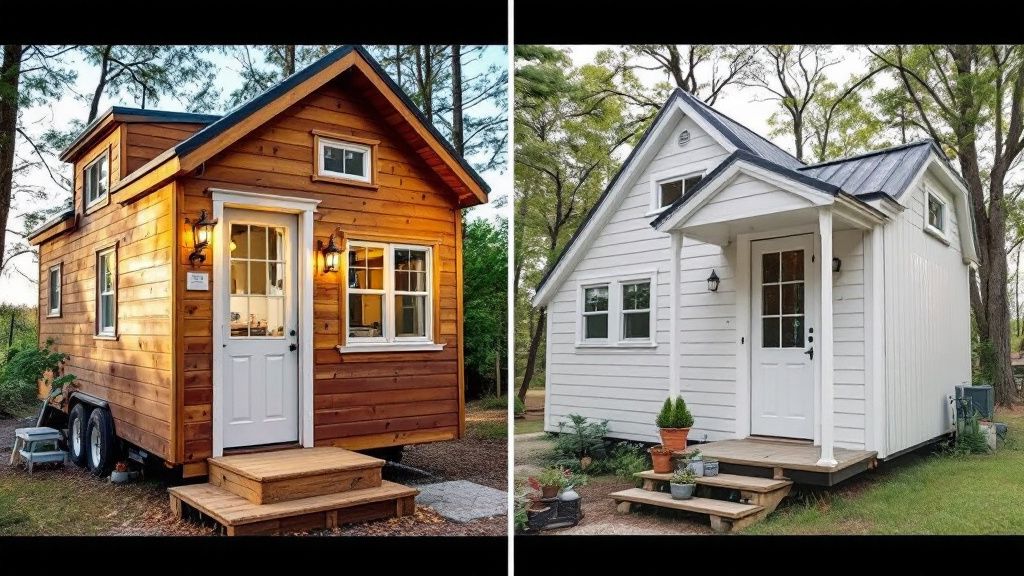The Secret to Your Perfect Tiny House Purchase
- California Tiny House
- 3 days ago
- 6 min read
Updated: 15 hours ago
Embarking on the journey to find your ideal tiny house can seem daunting, yet understanding the nuances of the buying process can be your key to success. By focusing on the core elements that define your dream home, you gain valuable insight into selecting the right property. Engaging with reputable tiny house builders ensures that your home meets quality standards and aligns with your vision. Exploring various tiny house design ideas can spark inspiration, allowing you to personalize your space effectively. Embracing the tiny house lifestyle goes beyond minimizing; it’s about optimizing every inch to reflect your unique preferences and needs, ultimately leading to a fulfilling living experience.

Understanding the Tiny House Movement
The tiny house movement has emerged as a compelling shift toward a minimalist and sustainable living philosophy. At its core, it encourages you to embrace simplicity, focusing on what truly matters while freeing yourself from unnecessary possessions. This lifestyle choice offers the possibility to reduce living costs and environmental impact, allowing you to live more consciously.
In the tiny house lifestyle, every detail counts. From choosing eco-friendly materials to optimizing space with clever storage, the movement emphasizes thoughtful, intentional design. Engaging with skilled tiny house builders can guide you in implementing innovative tiny house design ideas that maximize functionality and enhance livability within a small footprint.
Exploring the vast possibilities within the tiny house movement can lead to creative solutions tailored just for you. Whether it’s finding multifunctional furnishings or discovering energy-efficient technologies, the choices available cater to diverse needs and preferences. This adaptability makes the tiny house lifestyle uniquely appealing to those seeking a customizable living arrangement.
Looking to the future, the tiny house movement is poised to expand its influence in urban and rural settings, reflecting growing interest in sustainable development. As more individuals adopt this way of life, the community is expected to evolve, incorporating advanced designs and increased accessibility to suit a wider range of inhabitants.

Defining Your Needs
Before venturing into your tiny house journey, it’s essential to precisely define what you need from your living space. Consider how your lifestyle aligns with the compact nature of tiny living. Think about the must-have features that will enhance your daily life, such as kitchen setup, storage solutions, and workspace preferences. Collaborating with experienced tiny house builders can help ensure each element meets your standards, transforming dream into reality.
Delve into the versatility of your tiny house by assessing potential future adaptations. Flexible design ideas can accommodate life changes or new preferences, keeping your home harmonious with your evolving needs. Tracing its evolution from the late 1990s when pioneers like Jay Shafer popularized the movement, tiny houses have become a symbol of minimalist living. This historical context emphasizes the importance of adaptability for enduring satisfaction in your tiny dwelling.
By understanding what truly matters to you, from location preferences to layout configuration, you lay the foundation for a happy and functional tiny house lifestyle. Each decision should reflect both your present needs and potential future adjustments, ensuring your tiny home remains a source of comfort and joy. This thoughtful preparation sets the stage for a fulfilling life in a smaller space, maximizing every inch while remaining true to your personal ideals.

Exploring Different Tiny House Types
Diving into the world of tiny houses reveals a variety of styles. Each type offers unique benefits suited to different needs. Tiny houses on wheels provide mobility, allowing you to take your compact lifestyle anywhere. This flexibility is ideal for those who crave new experiences and changing sceneries while maintaining a comfortable living environment.
Tiny houses on foundations offer a more permanent solution, similar to traditional homes but on a smaller scale. These homes often boast durable materials and stable structures, appealing to those who appreciate rootedness. With the option to build on your own land, working with tiny house builders can bring your vision to life, reflecting your personal tastes and needs.
Exploring alternative designs, such as container homes or yurts, expands the realm of possibilities. Each offers an innovative approach to minimal living, tapping into eco-friendly materials and sustainable practices. Did you know? Approximately 40% of tiny house enthusiasts prefer unique designs like these for their environmental benefits and distinct aesthetic appeal.
Whether you're drawn to a mobile lifestyle or a stationary dwelling, understanding these different types helps in making an informed decision. By tailoring your choice to your lifestyle, you can fully embrace the tiny house movement, creating a space that’s perfectly aligned with your values and aspirations. This exploration empowers you to find the ideal tiny house type, ensuring comfort and satisfaction.

Deciding Between New and Pre-owned Tiny Houses
Choosing between a new and pre-owned tiny house is a significant decision in your tiny house journey. Opting for a new home provides customization opportunities that align perfectly with your vision. Working closely with tiny house builders allows you to dictate design specifics and integrate modern amenities, ensuring that your new abode embodies the latest tiny house design ideas.
On the other hand, pre-owned tiny houses offer financial advantages and immediate availability. While many believe that new homes are superior due to customization options, there’s a strong case for pre-owned homes being cost-effective and character-rich. These homes often come equipped with unique features that reflect a lived-in charm, adding personality and warmth to your tiny house lifestyle.
Evaluating the pros and cons of each option helps you make an informed choice. New homes may entail higher costs but guarantee a tailored experience, while pre-owned options provide budget-friendly solutions with existing character. Analyzing your priorities—whether they are financial, aesthetic, or functional—will help guide your decision, ultimately leading to satisfaction with your tiny living arrangement.

Financing Your Tiny Home
Securing financing for your tiny home is a critical aspect of bringing your dream into reality. Traditional financing methods might seem elusive, but alternatives exist. Personal loans, RV loans, or financing options directly from tiny house builders can provide viable paths. Engaging with lenders who understand the intricacies of the tiny house lifestyle can be beneficial in obtaining the necessary funds.
Exploring these options, you'll find that each has its set of criteria and benefits. Personal loans, for instance, offer flexibility without tying the loan to your property, while RV loans cater to tiny houses on wheels. Understanding these differences is essential in selecting the most suitable financial strategy for your situation.
In the next few years, financing for tiny homes is likely to become increasingly accessible, as the movement continues to gain traction and lenders adjust their offerings. This growing interest could lead to more tailored financial products designed specifically for tiny home enthusiasts, making it easier for you to fund your purchase efficiently.
Crafting a clear budget and assessing your financial abilities will help in mapping out a realistic plan. Incorporating the costs of land, materials, and customization ensures a comprehensive understanding of your investment. By proactively addressing these financial considerations, you set a strong foundation for a successful tiny house venture.
Navigating Zoning Laws and Building Codes
Understanding zoning laws and building codes is crucial as you embark on your tiny house journey. These regulations vary widely and can impact where and how you can place your home. It's important to research your chosen area diligently, as some jurisdictions embrace the tiny house lifestyle, while others have more restrictive measures in place that may require adjustments to your plans.
In some regions, tiny houses are classified as accessory dwelling units (ADUs), which allows them in certain residential areas. For example, Portland, Oregon, is known for being tiny house-friendly, with zoning laws that support ADUs, enabling you to more easily place a tiny home on an existing residential property. This exemplifies how location can significantly influence your ability to integrate your tiny house into a community.
Building codes also vary and can dictate design and construction requirements. Engaging with knowledgeable tiny house builders who understand these nuances can help ensure compliance and avoid costly adjustments. Codes may address issues like ceiling height, emergency exits, and plumbing, all of which can influence your design choices and overall expenditure.
Navigating these legalities can be daunting, but understanding them is essential for a seamless transition into tiny house living. Prioritize thorough investigation and seek local expert advice where necessary. By aligning your housing goals with local regulations, you create a solid framework for enjoying all the benefits that a well-situated tiny house lifestyle offers. Making informed decisions early on mitigates risks and supports a harmonious living experience.




